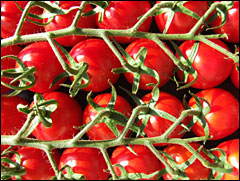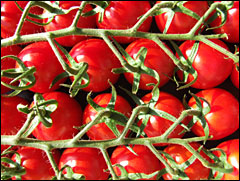It’s mid-August and the Pioneer Valley of western Massachusetts is filled with crops that are making their final push to ripeness and fruition. On a warm day, the air feels like it is practically vibrating with all that energy. As I drive to the Hampshire College campus for the annual Northeast Organic Farmers’ Association conference, I pass fields of corn that seem to have reached their peak. The corn is so tall, I am amazed to think that each stalk was a mere seed just a few short months ago. It’s mind-boggling to think of the amount of energy — and complex genetic instructions — contained in each seed.

Fuel for a tomatoey sandwich.
Photo: iStockphoto
When I arrive at the campus, I am greeted by the sweet fragrance of newly mown grass, and a gentle breeze accompanies me as I trudge up the hillside to the registration tent. After checking in, I wend my way down a path through the hemp and/or spelt district — stalls where people are selling every product ever made of either or both substances. Next I check out the books and bumper stickers. (Although the best bumper sticker I’ve seen on my trip so far was in Northampton. It said, simply, “Completely Appalled.”)
Next I face the always-daunting task of trying to decide which workshops to attend. I’ve attended this conference before, and I like coming here to learn about gardening, cooking, and farming, as well as agricultural policy. But it’s always tough to pick a session: Growing shiitake mushrooms? Felting? Making dairy products at home? Using red wigglers to compost indoors? Domestic fair trade? Peak oil and sustainable agriculture? Keeping urban hens? Eating locally? There were 212 offerings for the hundreds of attendees at this gathering. Don’t make me choose!
I choose the shiitake mushroom workshop, because I like to use them in soups and sauces. Led by Elaine Peterson, the session is well attended — about two dozen people fill the room — and I feel lucky to get one of the last seats. Elaine gives a PowerPoint presentation that shows all the stages of growing the mushrooms in logs; how to choose the right wood, how to inoculate the log with the plug spawn (mushroom “starter” that you can order through the mail), how to cap the ends of the logs so that other forms of fungus don’t develop, and how to harvest and dry the shiitake mushrooms. Elaine mentions that the logs get much lighter as the mushrooms consume them. This makes complete sense, of course, but it had never really occurred to me. Best of all, these mushrooms grow well in shade. My tiny postage stamp of a yard is almost completely shaded, so I am pleased to think that there is some form of food I can grow, even if it’s not a green vegetable.
At dinnertime, I visit a friend who lives nearby. My friend’s garden is full of tomatoes, both large and small, and I make a gloriously tomatoey sandwich for dinner. There’s a bit of cheese, but mostly it’s just tomato, tomato, and tomato. My friend serves a delicious fruit salad for dessert. She’s made it out of peaches, nectarines, and locally grown, organic cantaloupe, watermelon, and yellow watermelon. We add some organic red grapes (cut into halves, a nicety that she and I always insist upon) and a few organic cherries — whose food-miles have been increased exponentially by the fact that I dragged them all the way out here from Boston, then let them languish in my car all day long. Miraculously, they’re still quite fresh. She adds a pinch of superfine sugar and creates the most delicious fruit salad imaginable.
Her son is present. It seems like only yesterday that she called me and, in a drowsy voice, whispered into the phone, “I had a baby.” I was shocked, because her due date was two months into the future. I asked her, “A boy or a girl?” She sighed dreamily and, in her post-surgical fog, just repeated “A baby.” The preemie that I visited in intensive care now stands before me. At 14, he is a human sapling. Lanky and thin, he stands 5 feet 11 inches tall. He surpassed both his mother and me sometime earlier this year, and he is closing in on his dad. I can’t believe that even humans can grow so much and so well, made up of all that energy and all those genetic instructions. (And, of course, all those delicious meals prepared by his mom.)
I know that if we paid adequate attention to all of these miracles — really and truly gave them their due — we would never be able to get anything else done. I also know, however, that if we don’t stop to marvel at these things now and then, we will never understand and appreciate them fully, and, as a consequence, we will never be able to get anything done. This fleeting moment of peak growth, of plants straining to complete their seed-producing mission, of living things going flat-out as they sprint toward the end of the growing season, seems as good a time as any to stop and look around.
Maple Basil Dressing
It’s fabulous on a tomato salad. It’s fabulous on almost anything. This recipe makes just over a cup. You don’t need to make it in a blender, but it’s easier and will be better emulsified if you do.
1/3 cup red wine vinegar, balsamic vinegar, or a combination of the two
1 tablespoon fresh lemon juice
1/2 teaspoon minced fresh garlic
1/4 teaspoon salt or more to taste
1/4 teaspoon ground black pepper or more to taste
1-2 tablespoons maple syrup, to taste (start with 1 tablespoon, then taste)
1/2 teaspoon mustard (I like Gulden’s Golden Brown)
1/2 cup fresh basil leaves, torn into small pieces
Mix all the ingredients together in a blender except for the basil leaves. Whirl it around until it is completely mixed. Taste the dressing. Adjust the garlic, salt, pepper, and maple if need be. Now add the basil leaves and whirl it around in the blender until they are completely broken down and incorporated throughout the dressing. Serve over sliced tomatoes, green salad, rice, or barley.


